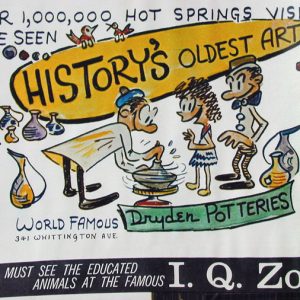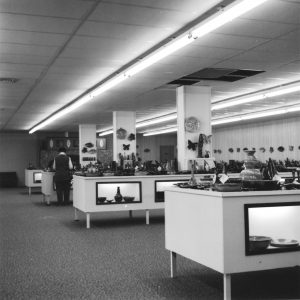calsfoundation@cals.org
Dryden Pottery
Dryden Pottery was founded in Kansas by A. James Dryden, who relocated his business to Hot Springs (Garland County) in 1956. Dryden Pottery has become collectible and has been listed in Schroeder’s Antique Guide for many years.
Dryden, the son of a successful hardware merchant in Ellsworth, Kansas, grew up working in his father’s store. After serving during World War II in the South Pacific, he returned to Ellsworth and needed a job. He had always had an interest in art with a special aptitude for cartooning, but his attempts at cartooning for publication were not going to support his family. A chance meeting on the streets of Ellsworth with nationally known ceramicist Norman Plumber presented Dryden with an idea that led to combining his interest in art with producing pottery. He then studied ceramics at the University of Kansas under Sheldon Carey, and after many trials over a relatively short period of time, Dryden Pottery was born in Ellsworth, its first sales taking place in his father’s Dryden Hardware store in 1946.
Using many innovative sales techniques—such as making personalized pottery for customers, holding pottery-making contests for school kids, issuing a blizzard of cartoon ads showing the use of local materials, placing distinctive labels on each sale piece, giving tours of the pottery, and providing a rattlesnake attraction and ice water—Dryden’s business grew, and though his colorful handmade cast pottery was sold across the United States, he wanted a locale with more traffic. He did an extensive survey of locales all around the country, looking for an area offering local raw materials and the largest number of hotel rooms per capita. For those two reasons, he chose Hot Springs. He relocated his family, the kilns, start-up materials, and plaster molds to Hot Springs in 1956.
As for raw materials, Dryden found clay used in brick making at nearby Malvern (Hot Spring County) and was allowed to dig there. Talc came from Bryant (Saline County). Quartz, used in pottery glazes, was abundant in the Ouachita Mountains. Dryden’s customers consisted largely of people streaming to the area to visit Hot Springs National Park, Oaklawn Racing Casino Resort, and other tourist attractions.
Dryden was warmly welcomed into the Hot Springs business community. He had purchased land and a building at 341 Whittington Avenue, near Hot Springs National Park. He applied his successful Kansas business model to his new Arkansas setting: long work hours with varied and creative advertising schemes—often depicting cartoon characters—which encouraged people to visit the factory and watch craftsmen at work before entering the salesroom. He continued his use of a high-speed dental drill to personalize pre-fired pottery before glazing and final firing and, in this way, produced a time-consuming but highly appealing souvenir. A large showroom invited shoppers, and busloads of people were treated to free tours of the spacious factory, with his employees describing the steps at a series of stops between raw materials and finished product.
Dryden Pottery changed over time. Building additions were constructed and high-capacity kilns installed. From the molded or poured clay work of the Kansas and early Arkansas years, the balance rapidly shifted until the product was predominately “thrown” pottery. Dryden’s son, James K. (“Kimbo”), learned wheel-made pottery, as did a number of Dryden employees. The thrown pottery was marked with the potter’s initials and year of production. A Dryden logo decal was also attached to these one-of-a-kind pieces. Over the years, each employee-potter developed a distinctive style. Artistry and creativity were encouraged through the employment of local decorators who added clay relief designs to some thrown pieces and painted glaze motifs to others. Dryden painted in glaze on some of his son’s thrown pots; his favorite motif was his signature cartoon fish.
Dryden Pottery is a three-generation family business, and Kimbo Dryden’s sons now also add their artistry, which includes porcelain pieces, added glasswork, crystal glazing, and a few Raku pots.
For additional information:
Dryden Pottery. https://www.drydenpottery.com/index.html (accessed November 8, 2022).
“Dryden Pottery.” Kansas State Historical Society. http://www.kshs.org/cool/drydenpottery.htm (accessed March 30, 2022).
Dybwad, G. L., and Joy V. Bliss. Dryden Pottery of Kansas and Arkansas. Albuquerque, NM: The Book Stops Here, 2001.
G. L. Dybwad and Joy V. Bliss
The Book Stops Here
 Dryden Advertisement
Dryden Advertisement  Dryden Pottery Showroom
Dryden Pottery Showroom  Dryden Vase
Dryden Vase  Dryden Pottery
Dryden Pottery  Dryden Pottery
Dryden Pottery  James Dryden
James Dryden  Dryden Vase
Dryden Vase  Dryden Showroom
Dryden Showroom 



Comments
No comments on this entry yet.